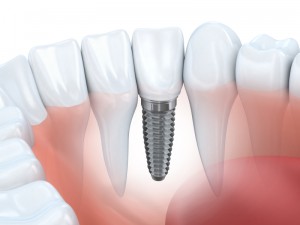 Dental implants are used as a tooth replacement option that’s meant to mimic your natural teeth as much as possible. Unlike regular dentures and dental bridges, implants help to support your replacement teeth so they don’t fall out. Your new teeth will also be permanent, and you won’t be able to remove them once the procedure is complete.
Dental implants are used as a tooth replacement option that’s meant to mimic your natural teeth as much as possible. Unlike regular dentures and dental bridges, implants help to support your replacement teeth so they don’t fall out. Your new teeth will also be permanent, and you won’t be able to remove them once the procedure is complete.
Dental Implant Uses
Dental implants are seen as artificial roots for prosthetic teeth. This artificial root can be used to support a variety of crowns, like a single tooth crown, dental bridge or even dentures. Dental implants can be used to support both permanent and removable teeth, and are often used to support removable dentures that clip onto the implants.
Of course, supporting your replacement teeth with dental implants can improve your quality of life. On top of better living, dental implants have been shown to have health benefits, such as slowing degeneration of bone tissue in your jaw. In turn, having full, healthy bone tissue in the jaw prevents your face from aging.
It might not be something most people think of, but your jaw has a huge influence on what your face looks like. As you age, the bone density of your jaw naturally deteriorates, leaving your face with a sunken in appearance. Losing teeth speeds up this aging process, as it’s a known fact that tissues deteriorate faster where you no longer have tooth roots to stimulate bone growth.
Currently, dental implants prove to be the most effective treatment for preventing these common problems associated with tooth loss. Because the dental implant fuses with your jaw bone tissue through a process called osseointegration, it stimulates bone growth. And so – as an added benefit on top of better living – dental implants also help to keep you looking younger for longer.
Types of Dental Implants
 When you look at dental implants as a replacement for the tooth root tissue you lose during extraction, there are a number of different kinds of implants dentists use. The kind of implant you get will depend mainly on recommendations from your dental implant specialist after examining your current oral health, your desired outcome and other factors such as long-term sustainability.
When you look at dental implants as a replacement for the tooth root tissue you lose during extraction, there are a number of different kinds of implants dentists use. The kind of implant you get will depend mainly on recommendations from your dental implant specialist after examining your current oral health, your desired outcome and other factors such as long-term sustainability.
Two of the most common kinds of implants however, include endosteal and subperiosteal implants.
Endosteal Implants
As the name would suggest, this kind of implant is in bone, where “endo” is a prefix from Greek meaning “in”, “within” or “inside”, and “steal” is derived from the medical term “steum”, meaning bone. The suffix “steal” would therefore mean “of bone”.
Endosteal implants are often used to replace single tooth crowns. They set the basic standard for what dental implants are, and so they can be seen as traditional, or conventional implants. That’s not the say other implants are bad, but rather that endosteal implants are commonly used.
Endosteal implants are placed inside the jawbone. They are usually shaped a lot like regular tooth roots are, and so the implants look like a cylindrical post. To insert an endosteal implant into the jaw, your dentist will drill a hole in which to insert the implant post. After a few months of healing and fusing to your jaw, your new implant will be ready to support your replacement teeth.
Subperiosteal Implants
Subperiosteal implants aren’t actually surgically implanted into the jawbone itself. Instead, the implant looks a bit like a wire rack that rests on the jawbone underneath the gums.
Once again, the name accurately describes the implant. Where “sub” is a prefix meaning “under” or “beneath”. And “perio” is a prefix derived from Greek that refers to “enclosing” or “surrounding” something. When combined with the suffix “steal” (that means “of the bone”), the name of this kind of implant means that it’s under the covering of the bone – your gums, in this case. On the framework that fits over your jaw, there are attachment points for your new teeth to fit onto.
Transosteal Implants
Transosteal implants can only be used for the lower jawbone, but they aren’t widely popular. With transosteal implants, screws run right through your jawbone and are attached to a metal plate at the bottom. This metal plate will usually rest just underneath the bone at your chin. Your dental implant specialist is unlikely to recommend this kind of implant for you, as the procedure can be rather more extensive than with the other options.
If you would like to learn more about dental implants, feel free to book an appointment with Dr. Stone. Dr. Stone is a dental implant specialist registered with The American College of Prosthodontists. With more than twenty years’ experience placing dental implants, you can be sure you’re in good hands with Dr. Stone and his team.
http://www.aaid-implant.org/about-dental-implants/what-types-of-dental-implants-are-available/
http://www.colgate.com/en/us/oc/oral-health/cosmetic-dentistry/implants/article/what-are-dental-implants
https://quizlet.com/13841146/anatomy-prefixes-and-suffixes-flash-cards/


